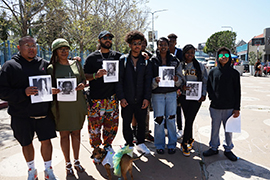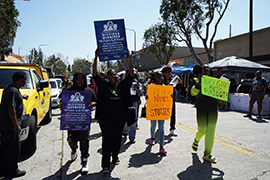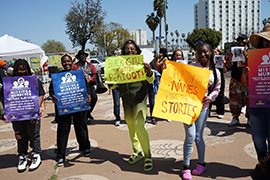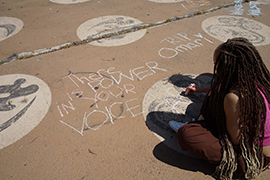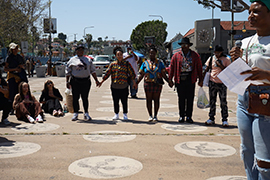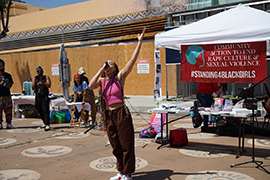- Slug: BC-CNS-Missing Black Women,720.
- 8 photos, audio story available (thumbnails, captions below).
By Ayana Hamilton
Cronkite News
LOS ANGELES – Black girls and women are murdered or go missing at rates far higher than for other major racial groups.
It’s a statistic that the Guardian, which discovered the depth of the issue through a data analysis, called an “unspoken epidemic” when it comes to homicides.
In the diverse Leimert Park section of Los Angeles, Black women recently came together to share their stories, sing, and chant about the injustice Black girls face, whether it’s crime or lack of access to health care.
“We will never go to sleep and turn our backs on Black girls who are suffering, who are dying, who are crying out for mentors and crying out for care,” said founder Sikivu Hutchinson of the Women’s Leadership Project’s Standing 4 Black Girls, which organized the consciousness-raising event.
The racial disparity in the response missing and murdered Black girls get from the police and newsrooms is an increasing problem, leaders said.
Data from the FBI’s National Crime Information Center shows that 35% of 546,568 people reported missing in 2022 were Black. The male/female divide was roughly equal. Yet Blacks composed about 13% of the overall U.S. population that year, according to the most recent U.S. Census data.
In analyzing 2020 murder rates, the Guardian found that Black girls and women were four times more likely to die by violence than white women or Latinas. The carnage had become so severe that Black and Indigenous girls and women faced a higher risk of being murdered that year than white boys or men.
At the event, Hutchinson quoted the late writer and poet Audre Lorde, a Black lesbian feminist, in calling out “the lack of amplification of the battered, bruised, scarred, beaten, and dead sisters and daughters that comprised our communities.”
Hutchinson said the group started the hashtag #Standing4BlackGirls on Instagram at the height of the pandemic to address the fact that there are many Black girls who couldn’t find affordable health care.
It isn’t just murders or disappearances that are of concern. From 2003 to 2019, the rates of suicide among Black girls, 12 to 14 years old, increased by 49%, Hutchinson said.
Despite the grim statistics, the event sought to bring people together through music and art.
A singer and songwriter, Honey Bluu, performed while Nina Rose, a woman who helps others deal with the deaths of loved ones, (she refers to herself as a “death doula”) created a grieving circle. Participants formed a circle, held hands, were told to focus on their breathing and were asked to remember those who have died.
Rose passed around chalk and asked people to write whatever came to mind to honor the Black girls and women who have disappeared or died. One wrote, “There is power in your voice.” Several wrote #Matrice or other references to a promising young woman, Mitrice Richardson, who is among the many who died too young and whose deaths remain unsolved.
Richardson was a 24-year-old college graduate who went missing on Sept. 17, 2009. She had been arrested after experiencing a mental health crisis – acting erratically in a restaurant – and had been taken to the Los Angeles County Sheriff’s Malibu/Lost Hills station in Agoura, California.
Richardson was missing for 11 months before being found dead by park rangers in August 2010. Her murder has never been solved.
Ronda Hampton, a psychologist, said that she first heard the term “missing white woman syndrome” during the search for Richardson.
The late PBS news anchor Gwen Ifill coined the term in a speech to point out the mainstream media’s fascination with covering missing or endangered white women, and its seeming disinterest in cases involving missing people of color.
A recent example was the disappearance of vagabond blogger Gabby Petito in 2021, a white woman who was subsequently found murdered. While the Petito case received blanket news coverage, relatives of Black missing persons around the country asked why their loved ones haven’t received the same attention.
Hampton said Richardson’s story opened her eyes to the other missing Black women out there whose stories were overlooked by the media.
Now she uses her time to bring justice and attention to the violence Black girls face.
For more stories from Cronkite News, visit cronkitenews.azpbs.org.
^__=
Event-goers marched around Leimert Park chanting, “We’re standing for Black girls!” (Photo by Ayana Hamilton/Cronkite News)
Before the event, marchers grabbed posters of missing Black women to spread awareness. (Photo by Ayana Hamilton/Cronkite News)
Ronda Hampton, a psychologist, was among the marchers. She was loud and proud about bringing justice to Black girls. (Photo by Ayana Hamilton/Cronkite News)
Standing4BlackGirls is a women-led movement that works to raise awareness for Black mental health. (Photo by Ayana Hamilton/Cronkite News)
Event-goers expressed grief over the Black girls who are missing or who lost their lives to violence. (Photo by Ayana Hamilton/Cronkite News)
Event-goers used chalk to participate in a grief circle. It’s a safe space to express grief over the Black girls who lost their lives to violence. (Photo by Ayana Hamilton/Cronkite News)
Marchers gathered in a circle to remember the Black women and girls who have been murdered or been reported missing. They hope the activism will help spur action. (Photo by Ayana Hamilton/Cronkite News)
Honey Bluu is a singer/songwriter who grabbed the attention of people with her singing. (Photo by Ayana Hamilton/Cronkite News)

